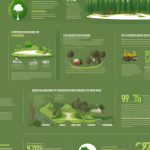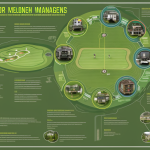Golf courses have long been a symbol of luxury and exclusivity, but their environmental impact has been a subject of growing concern in recent years. These seemingly pristine landscapes are often maintained at the expense of the environment, leading to degradation of local ecosystems and increased carbon emissions. In this article, we will explore the challenges that golf courses pose to sustainability and the efforts being made to mitigate their environmental impact. From water usage to pesticide use, we will examine the various ways in which golf courses are failing to live up to the sustainability standards that we expect from our green spaces. Join us as we take a closer look at the environmental impact of golf courses and the sustainability challenges they present.
The Growing Popularity of Golf Courses
The Global Expansion of Golf Courses
The Spread of Golf Courses in Developed Countries
In developed countries, the number of golf courses has steadily increased over the past few decades. This growth can be attributed to the rising popularity of golf as a recreational activity and the increasing economic wealth of these nations. The United States, Canada, the United Kingdom, and Australia are some examples of countries where the expansion of golf courses has been particularly pronounced.
The Emergence of Golf Courses in Developing Countries
In recent years, the development of golf courses has also expanded to developing countries. This growth can be attributed to the increasing interest in golf as a sport and the influx of foreign investment in these nations. Countries such as China, India, and South Africa have seen significant growth in the number of golf courses, as the sport has become more popular among the middle and upper classes.
The Impact of Golf Course Expansion on the Environment
The global expansion of golf courses has led to a variety of environmental impacts. The construction of golf courses often involves the clearing of large areas of land, which can lead to habitat destruction and the loss of biodiversity. In addition, the maintenance of golf courses requires the use of large amounts of water, pesticides, and fertilizers, which can lead to water pollution and soil degradation. Furthermore, the transportation of golfers to and from courses contributes to greenhouse gas emissions and traffic congestion.
Economic Impact of Golf Courses
Golf courses have become a significant contributor to the economy in many countries around the world. The construction and maintenance of golf courses provide employment opportunities for local communities, and the industry generates substantial revenue through green fees, memberships, and related services.
According to a report by the World Golf Foundation, the golf industry in the United States alone generates over $70 billion in economic impact annually. This figure includes the direct spending by golfers, as well as the indirect and induced effects of the industry on the broader economy.
In addition to the economic benefits, golf courses also provide a valuable source of recreation and leisure for local residents and tourists. This can contribute to the overall quality of life in a community and attract visitors to the area, which can further boost the local economy.
However, it is important to recognize that the economic benefits of golf courses come at a cost to the environment. The construction and maintenance of golf courses require significant amounts of land, water, and other resources, which can have a negative impact on local ecosystems and wildlife. Therefore, it is essential to balance the economic benefits of golf courses with their environmental impact and find ways to make the industry more sustainable.
Environmental Costs of Golf Course Development
Golf courses are a popular leisure activity around the world, with millions of people playing the sport regularly. The increasing demand for golf courses has led to the development of new courses, which in turn has resulted in significant environmental costs.
Land Use
One of the primary environmental costs of golf course development is the land use change. Golf courses require large areas of land, often converting natural habitats such as forests, wetlands, and grasslands into golf courses. This land use change can result in the loss of biodiversity and habitat destruction, leading to a decline in local wildlife populations.
Water Use
Golf courses are notorious for their high water use, with some courses using up to 1 million gallons of water per day. This water use puts a strain on local water resources, especially in areas where water is already scarce. Additionally, the water used on golf courses often contains chemicals and pesticides, which can contaminate local water sources and harm aquatic life.
Energy Use
Golf courses require a significant amount of energy to maintain, including the use of gas-powered equipment, heating and cooling of buildings, and lighting for night play. This energy use contributes to greenhouse gas emissions and climate change, as well as increased energy costs for course maintenance.
Chemical Use
Golf courses also rely heavily on the use of chemicals, including pesticides and fertilizers, to maintain the quality of the turf and control pests. These chemicals can run off into local water sources, harming aquatic life and contaminating drinking water. Additionally, the use of chemicals can result in air pollution, especially during the application process.
Waste Generation
Golf courses generate a significant amount of waste, including grass clippings, leaves, and branches, which are often disposed of in landfills. Additionally, the use of single-use plastics, such as plastic cups and bottles, can contribute to pollution and litter in and around golf courses.
Overall, the environmental costs of golf course development are significant and require careful consideration and management to minimize their impact on the environment.
Water Usage in Golf Courses
Water Consumption of Golf Courses
Golf courses are notorious for their high water consumption, with many courses requiring large amounts of water to maintain their pristine conditions. In fact, a typical golf course can use up to 2 million gallons of water per day, which is a staggering amount considering the limited availability of freshwater resources in many regions.
One of the main reasons for the high water consumption of golf courses is the need to maintain lush green grass and manicured landscapes. This requires regular irrigation, often through the use of sprinklers and other watering systems, which can lead to significant water waste. In addition, many golf courses have large lakes and ponds that are used to store and reuse water, but these bodies of water can also become breeding grounds for mosquitoes and other pests, leading to public health concerns.
Another factor that contributes to the high water consumption of golf courses is the use of chemicals to treat the water. Many golf courses use fertilizers and pesticides to maintain the health and appearance of their turf, but these chemicals can contaminate the water supply and harm local ecosystems. Furthermore, the disposal of these chemicals can also lead to environmental pollution, which can have long-term effects on the health of both humans and wildlife.
To address these sustainability challenges, many golf courses are implementing new technologies and practices to reduce their water consumption. For example, some courses are using drought-resistant grasses and alternative landscaping to reduce the need for irrigation, while others are installing water-saving irrigation systems and recycling greywater for reuse. These efforts are helping to reduce the environmental impact of golf courses and promote more sustainable practices within the industry.
Impact of Drought on Golf Courses
Droughts can have a significant impact on golf courses, which are heavily dependent on water for their maintenance. In areas where water resources are scarce, golf courses can consume a substantial amount of water, leading to water scarcity for other uses. The impact of drought on golf courses can be severe, affecting not only the golf course but also the surrounding ecosystems.
When a golf course experiences drought, it can result in the drying up of ponds, lakes, and other water features, which can lead to the death of fish and other aquatic life. Drought can also cause the grass on the golf course to turn brown and die, affecting the aesthetics of the course and reducing its playability. In addition, drought can lead to the development of bare spots and weeds, which can further degrade the quality of the course.
The impact of drought on golf courses can also have a broader environmental impact. Golf courses are often located in areas with high biodiversity, and drought can affect the habitat of local wildlife. In addition, the use of irrigation systems to maintain golf courses can lead to the loss of groundwater resources, which can impact nearby ecosystems.
To mitigate the impact of drought on golf courses, golf course managers can implement various water-saving measures. These measures can include the use of drought-resistant grasses, the installation of efficient irrigation systems, and the use of recycled water. Golf courses can also work with local authorities to implement water conservation measures, such as restricting water use during times of drought.
Overall, the impact of drought on golf courses can be significant, affecting both the quality of the course and the surrounding environment. Golf course managers can take steps to mitigate this impact by implementing water-saving measures and working with local authorities to conserve water resources.
Water Conservation Strategies in Golf Courses
As the world faces increasing water scarcity, golf courses have come under scrutiny for their high water usage. In response, many golf courses have implemented water conservation strategies to reduce their environmental impact. Here are some of the key measures that golf courses can take to conserve water:
- Irrigation System Efficiency: One of the most significant water-saving measures that golf courses can take is to improve the efficiency of their irrigation systems. This can include using precision irrigation techniques that target specific areas of the course that need watering, using sensors to detect soil moisture levels, and adjusting irrigation schedules based on weather conditions.
- Greens Speed: Another strategy is to increase the speed of greens, which can reduce the need for watering. Faster greens require less water because they are more resistant to drought and can better withstand high temperatures. By increasing the speed of greens, golf courses can reduce their water usage without compromising the quality of the playing surface.
- Water Recycling: Golf courses can also implement water recycling systems to reduce their reliance on freshwater sources. This can include collecting and treating wastewater from the course, as well as capturing and storing rainwater for later use. By recycling water, golf courses can reduce their overall water usage and help to conserve this valuable resource.
- Native Plant Selection: Golf courses can also reduce their water usage by selecting native plants that are adapted to the local climate and soil conditions. These plants are typically more drought-tolerant than non-native species, which can reduce the need for irrigation and help to conserve water resources.
- Education and Awareness: Finally, golf courses can reduce their water usage by educating players and staff about the importance of water conservation. This can include providing information about the environmental impact of golf courses, as well as offering tips and advice on how to conserve water both on and off the course. By raising awareness and promoting sustainable practices, golf courses can help to reduce their environmental impact and contribute to a more sustainable future.
Energy Consumption in Golf Courses
Energy Usage in Golf Course Operations
Energy consumption in golf courses is a significant aspect of their environmental impact. Golf courses rely heavily on energy for various operations, including maintenance, irrigation, and heating/cooling. This section will delve into the energy usage in golf course operations and identify the primary sources of energy consumption.
Irrigation Systems
Irrigation is a crucial aspect of golf course maintenance, and it is also a significant contributor to energy consumption. In many cases, golf courses use high-pressure irrigation systems that require a substantial amount of energy to operate. The energy usage can be further increased during the summer months when the demand for water is higher due to increased evapotranspiration.
Lighting
Golf courses often have extensive lighting systems, including streetlights, floodlights, and security lights. These lighting systems are typically powered by electricity, which contributes to the overall energy consumption of the golf course. Additionally, some golf courses may use lighting systems for extended periods, such as during night games or for special events, which can significantly increase energy usage.
Heating and Cooling
Golf courses often have large buildings that require heating and cooling, such as clubhouses, pro shops, and maintenance facilities. These buildings can consume a significant amount of energy, particularly during extreme weather conditions. In addition, some golf courses may use energy-intensive heating systems, such as boilers or furnaces, to maintain optimal temperatures for turf growth.
Vehicle Fleet
Golf courses typically have a fleet of vehicles, including golf carts, utility vehicles, and maintenance equipment. These vehicles often run on gasoline or diesel fuel, which contributes to greenhouse gas emissions and climate change. Additionally, the regular maintenance and replacement of these vehicles can be energy-intensive, as they require the use of equipment and resources.
Other Energy Usage
Other sources of energy consumption in golf courses include the use of pumps for water features, such as lakes and fountains, and the operation of equipment such as mowers, tractors, and snow removal machines. These machines may run on gasoline or diesel fuel, which contributes to air pollution and climate change.
In conclusion, energy usage in golf course operations is a significant contributor to the environmental impact of golf courses. Understanding the primary sources of energy consumption can help identify opportunities for reducing energy usage and increasing sustainability.
Impact of Energy Consumption on the Environment
Energy consumption is a significant contributor to the environmental impact of golf courses. The energy requirements for golf courses are vast, including the operation of golf carts, heating and cooling of clubhouses, and the maintenance of irrigation systems. The environmental impact of energy consumption in golf courses can be broken down into several areas:
Greenhouse Gas Emissions
Golf courses are significant emitters of greenhouse gases, which contribute to climate change. The primary sources of greenhouse gas emissions from golf courses are the use of gasoline-powered golf carts and the operation of large compressors for irrigation systems. The use of golf carts results in the emission of carbon monoxide, nitrogen oxides, and particulate matter, which can negatively impact air quality and the health of nearby residents.
Water Consumption
Energy consumption is also linked to water consumption in golf courses. Irrigation systems require significant amounts of energy to operate, and the use of electric pumps can lead to high water consumption. The excessive use of water for irrigation can result in water scarcity in areas where water resources are already limited. This can have a negative impact on local ecosystems and communities that rely on these resources for their survival.
Energy consumption in golf courses also contributes to the generation of waste. The use of chemicals for maintenance and the operation of golf carts and other equipment generate hazardous waste that can contaminate soil and water resources. In addition, the disposal of batteries, tires, and other materials used in golf courses can also have a negative impact on the environment.
In conclusion, the impact of energy consumption on the environment is a significant sustainability challenge for golf courses. To mitigate this impact, golf courses can implement energy-efficient practices, such as using alternative sources of energy, reducing water consumption, and implementing waste reduction and recycling programs.
Energy Conservation and Renewable Energy in Golf Courses
Golf courses are significant consumers of energy, with an estimated annual energy consumption of 2.2 terawatt-hours globally. Energy conservation and the adoption of renewable energy sources are essential steps towards sustainability in the golf industry. Several initiatives have been implemented to reduce energy consumption and increase the use of renewable energy sources in golf courses.
Energy Efficiency Measures
Energy efficiency measures are a crucial aspect of energy conservation in golf courses. Some of the energy efficiency measures that have been implemented in golf courses include:
- Lighting: LED lighting is being used in golf courses to reduce energy consumption and improve energy efficiency. LED lighting is more energy-efficient than traditional lighting sources and has a longer lifespan.
- Irrigation: Water is a critical resource in golf courses, and efficient irrigation systems are essential to reduce water waste. Low-flow irrigation systems and smart irrigation systems are being used in golf courses to reduce water consumption and improve efficiency.
- Building insulation: Insulation is used to reduce heat loss in buildings, which helps to reduce energy consumption. Buildings in golf courses, such as clubhouses and maintenance facilities, are being insulated to improve energy efficiency.
Renewable Energy Sources
Renewable energy sources are being increasingly used in golf courses to reduce carbon emissions and dependence on non-renewable energy sources. Some of the renewable energy sources that are being used in golf courses include:
- Solar energy: Solar panels are being installed on golf courses to generate electricity from solar energy. Solar energy is a clean and renewable energy source that can significantly reduce energy consumption and carbon emissions.
- Wind energy: Wind turbines are being used in some golf courses to generate electricity from wind energy. Wind energy is a clean and renewable energy source that can significantly reduce energy consumption and carbon emissions.
- Biomass energy: Biomass energy is being used in some golf courses to generate electricity from organic waste materials such as grass clippings and wood chips. Biomass energy is a renewable energy source that can significantly reduce energy consumption and carbon emissions.
In conclusion, energy conservation and the adoption of renewable energy sources are crucial steps towards sustainability in the golf industry. Golf courses can significantly reduce their energy consumption and carbon emissions by implementing energy efficiency measures and using renewable energy sources. The adoption of sustainable energy practices in golf courses can contribute to a more sustainable future for the golf industry and the environment.
Land Use and Habitat Destruction
Land Acquisition for Golf Course Development
Golf course development often involves the acquisition of large tracts of land, which can have significant environmental impacts. Land acquisition for golf courses can result in the displacement of local communities, loss of agricultural land, and fragmentation of habitats. The process of land acquisition for golf course development typically involves several stages, each of which can have different environmental implications.
First, the land is typically identified and evaluated for its suitability as a golf course site. This evaluation may involve assessing the topography, soil conditions, and existing vegetation, as well as determining the potential for water supply and drainage. Once the site has been selected, the next step is to acquire the land. This can involve purchasing the land from private owners or obtaining it through eminent domain, in which case the government can seize the land for public use.
The acquisition of land for golf course development can have significant impacts on local communities. In some cases, the land may be used for agriculture or other purposes that provide important economic benefits to the community. The acquisition of this land for golf course development can result in the displacement of local farmers or other residents, leading to social and economic disruption.
In addition to the impacts on local communities, the acquisition of land for golf course development can also result in the fragmentation of habitats. Golf courses often require large areas of land, which can lead to the creation of isolated patches of habitat that are separated from larger contiguous areas. This can have negative impacts on wildlife, as it can make it more difficult for animals to move and migrate.
Finally, the acquisition of land for golf course development can also have impacts on water resources. Golf courses typically require large amounts of water for irrigation, which can put pressure on local water supplies. In addition, the construction of golf courses can alter the natural flow of water, which can impact downstream habitats and ecosystems.
Overall, the process of land acquisition for golf course development can have significant environmental impacts. These impacts can include the displacement of local communities, habitat fragmentation, and impacts on water resources. It is important for golf course developers to carefully consider these impacts and take steps to mitigate them, such as through the preservation of habitats and the use of drought-tolerant landscaping.
Habitat Destruction and Biodiversity Loss
Golf courses, with their expansive areas of closely mown grass and numerous artificial water bodies, have a significant impact on the environment. One of the most significant environmental challenges associated with golf courses is habitat destruction and biodiversity loss.
Impact on Natural Habitats
Golf courses often displace native vegetation and wildlife habitats, leading to a loss of biodiversity. This is because golf courses require large areas of land to be cleared, graded, and sculpted to create fairways, greens, and hazards. The removal of native vegetation can disrupt the ecological balance of an area, affecting the local wildlife and plant species.
Impact on Water Resources
Golf courses also have a significant impact on water resources. They require large amounts of water for irrigation, and the maintenance of their numerous artificial water bodies, such as ponds and lakes. This can lead to the depletion of local water resources, especially in areas where water is already scarce.
Impact on Soil Quality
Golf courses also have a significant impact on soil quality. The use of pesticides and fertilizers on golf courses can lead to soil contamination, which can have negative impacts on both the environment and human health. In addition, the removal of native vegetation can lead to soil erosion, which can negatively impact local water quality.
Impact on Climate Change
Golf courses also contribute to climate change, as the maintenance of their vast areas of closely mown grass and the use of energy-intensive equipment and transportation generate significant greenhouse gas emissions.
In conclusion, the environmental impact of golf courses is significant and far-reaching. Habitat destruction and biodiversity loss, water resource depletion, soil contamination, and contributions to climate change are just a few of the challenges associated with golf course development and maintenance. As such, it is essential to assess the sustainability challenges associated with golf courses and explore ways to mitigate their environmental impact.
Mitigating Habitat Destruction in Golf Course Design
Mitigating habitat destruction in golf course design involves implementing strategies that minimize the impact of golf courses on natural habitats while still providing a challenging and enjoyable golfing experience. One approach to mitigating habitat destruction is to incorporate native vegetation into the design of the course. This not only helps to preserve the natural habitat but also creates a more aesthetically pleasing and visually stimulating environment for golfers. Additionally, the use of native vegetation can also help to support local wildlife by providing a source of food and shelter.
Another strategy for mitigating habitat destruction is to incorporate water conservation measures into the design of the course. This can include the use of drought-tolerant grasses, the installation of irrigation systems that use recycled water, and the creation of wetlands and ponds that help to filter and clean water before it is used on the course. These measures not only help to conserve water but also help to reduce the amount of chemicals and fertilizers used on the course, which can have a negative impact on local ecosystems.
Finally, incorporating sustainable design principles into the design of the course can also help to mitigate habitat destruction. This can include the use of renewable energy sources, such as solar panels, to power course operations, the use of natural materials in construction and landscaping, and the incorporation of green spaces and natural habitat corridors into the course design. By incorporating these strategies into the design of the course, golf course architects and developers can help to reduce the environmental impact of golf courses and promote more sustainable land use practices.
Waste Management in Golf Courses
Types of Waste Generated in Golf Courses
Golf courses generate a variety of waste materials that can have a significant impact on the environment. Understanding the different types of waste generated in golf courses is essential for developing effective waste management strategies.
- Green waste: This includes grass clippings, leaves, and branches that are generated during the maintenance of the golf course. Green waste can be composted or used for biogas production.
- Food waste: Food waste from the golf course’s clubhouse or restaurant can be recycled or used for composting.
- Plastic waste: Plastic waste, such as plastic bottles, bags, and packaging, is a significant concern for golf courses. Plastic waste can be recycled or used for energy production.
- Pesticide and chemical waste: Golf courses use large quantities of pesticides and chemicals to maintain the quality of the turf. These chemicals can be hazardous and must be disposed of properly to prevent contamination of the soil and water.
- Construction waste: Construction waste, such as building materials and debris, is generated during the construction or renovation of golf courses. This waste can be recycled or used for energy production.
- Scrap metal: Golf courses often have metal equipment, such as golf carts and mowers, that can be recycled.
- Organic waste: Organic waste, such as leaves and grass clippings, can be used for composting or converted into biogas.
By identifying the different types of waste generated in golf courses, golf course managers can develop effective waste management strategies that minimize environmental impact and promote sustainability.
Recycling and Composting Initiatives in Golf Courses
As part of their commitment to sustainability, many golf courses have implemented recycling and composting initiatives to minimize waste and reduce their environmental impact. Some of the common recycling and composting initiatives in golf courses include:
- Organic waste recycling: Golf courses generate significant amounts of organic waste such as grass clippings, leaves, and tree branches. To reduce the amount of waste sent to landfills, many golf courses have implemented organic waste recycling programs. Organic waste is collected and processed into compost, which is then used as a nutrient-rich soil amendment in the golf course.
- Plastic recycling: Golf courses also generate significant amounts of plastic waste, such as plastic bottles, bags, and packaging. To reduce their environmental impact, many golf courses have implemented plastic recycling programs. Plastic waste is collected and processed into new products, such as park benches and playground equipment.
- Paper recycling: Golf courses also generate significant amounts of paper waste, such as paper towels, napkins, and cardboard boxes. To reduce their environmental impact, many golf courses have implemented paper recycling programs. Paper waste is collected and processed into new products, such as paper towels and toilet paper.
- Battery recycling: Golf courses also generate significant amounts of battery waste, such as batteries from golf carts and other electronic equipment. To reduce their environmental impact, many golf courses have implemented battery recycling programs. Battery waste is collected and processed into new products, such as batteries for golf carts and other electronic equipment.
These recycling and composting initiatives help golf courses reduce their waste, conserve resources, and minimize their environmental impact. However, more can be done to improve sustainability in golf courses. In the next section, we will discuss energy management in golf courses.
Reducing Waste and Environmental Impact in Golf Course Operations
- Implementing Sustainable Practices:
- Water Conservation Techniques: Installing drought-resistant grasses, using mulching machines to reduce water usage, and recycling water for irrigation purposes.
- Integrated Pest Management: Utilizing natural predators and biological controls to minimize the use of pesticides and herbicides.
- Proper Disposal of Waste: Implementing a recycling program for materials such as cardboard, paper, and plastic, and establishing partnerships with local composting facilities to dispose of organic waste.
- Energy Efficiency Measures:
- Upgrading lighting systems to LED bulbs to reduce energy consumption and costs.
- Implementing solar panels or wind turbines to generate renewable energy.
- Utilizing energy-efficient equipment and machinery in course maintenance operations.
- Promoting Sustainable Behavior:
- Educating golfers and staff about the importance of environmental sustainability and the role they can play in reducing waste and environmental impact.
- Encouraging the use of electric or hybrid golf carts, and providing charging stations for electric vehicles.
- Offering incentives for golfers who practice sustainable behaviors, such as recycling or using reusable water bottles.
- Monitoring and Reporting Progress:
- Tracking and measuring waste reduction and environmental impact metrics, such as the amount of waste diverted from landfills, water savings, and energy efficiency improvements.
- Communicating progress and successes to stakeholders, including golfers, staff, and the local community.
- Using data to identify areas for improvement and inform future sustainability initiatives.
The Role of Golf Course Communities in Waste Management
- Golf courses generate a significant amount of waste, including grass clippings, leaves, and branches, which must be properly managed to minimize their environmental impact.
- Golf course communities play a crucial role in waste management by implementing effective strategies to reduce, reuse, and recycle waste.
- One such strategy is composting, which involves converting organic waste into a nutrient-rich soil amendment that can be used to improve the health and appearance of golf course turf.
- Another strategy is the use of recycled materials in construction and landscaping projects, which can help reduce the demand for new resources and lower the environmental impact of golf courses.
- Additionally, golf course communities can encourage waste reduction by implementing recycling programs and educating golfers and staff about the importance of proper waste disposal.
- Collaboration with local government and community organizations can also help golf course communities access resources and expertise to develop effective waste management strategies.
- Overall, the role of golf course communities in waste management is critical to the sustainability of golf courses and the environment.
Chemical Usage and Pollution in Golf Courses
Pesticide and Fertilizer Use in Golf Courses
Golf courses often rely heavily on the use of pesticides and fertilizers to maintain the health and appearance of their turf. However, the excessive and indiscriminate use of these chemicals can have significant environmental impacts.
Pesticides are chemicals used to control pests, such as insects, weeds, and diseases. Golf courses use a variety of pesticides, including herbicides, insecticides, and fungicides. These chemicals can be toxic to both target and non-target species, and their overuse can lead to environmental pollution.
Fertilizers are used to provide nutrients to the turf, but excessive fertilizer use can lead to the excessive growth of turf, which can result in increased water usage, energy consumption, and greenhouse gas emissions. Additionally, fertilizer runoff can pollute nearby water bodies, causing eutrophication and harm to aquatic life.
Moreover, the use of pesticides and fertilizers can contribute to the development of pesticide-resistant pests and weeds, requiring the use of more toxic chemicals to control them. This can create a cycle of increased chemical use and environmental pollution.
To mitigate these environmental impacts, golf courses can adopt integrated pest management (IPM) practices, which aim to reduce the reliance on chemical pesticides and fertilizers. IPM involves using a combination of cultural, biological, and chemical control methods to manage pests and weeds. By adopting IPM practices, golf courses can reduce their chemical usage and minimize their environmental impact.
Soil and Water Pollution from Chemical Usage
Golf courses rely heavily on the use of chemicals to maintain their lush green turf and to control pests and weeds. However, the indiscriminate use of these chemicals poses significant environmental risks, particularly in terms of soil and water pollution.
One of the main sources of pollution on golf courses is the use of pesticides and herbicides. These chemicals are designed to kill unwanted plants and insects, but they can also harm beneficial species and contaminate soil and water. Pesticides can leach into groundwater, while herbicides can run off into nearby streams and rivers, causing harm to aquatic ecosystems.
In addition to pesticides and herbicides, golf courses also use fertilizers to maintain the health and appearance of their turf. However, excessive use of fertilizers can lead to nutrient runoff, which can cause eutrophication in nearby water bodies. Eutrophication occurs when an excess of nutrients, such as nitrogen and phosphorus, stimulates the growth of algae, which can deplete the oxygen in the water and harm aquatic life.
Another chemical commonly used on golf courses is fossil fuel-based turf care products, such as gasoline and diesel fuel. These products emit harmful pollutants into the air, contributing to air pollution and climate change. Additionally, the use of fossil fuels contributes to the depletion of natural resources and increases greenhouse gas emissions, which exacerbate the problem of climate change.
To mitigate the environmental impact of chemical usage on golf courses, many courses are turning to more sustainable and environmentally friendly alternatives. These alternatives include using natural pest control methods, such as predator insects and birds, and incorporating native plant species that require less maintenance and are more resistant to pests and diseases. Additionally, courses are implementing integrated pest management strategies, which focus on reducing the use of chemicals and using them only when necessary. By adopting these sustainable practices, golf courses can reduce their environmental impact and promote a more sustainable future for the sport.
Alternatives to Chemical Usage in Golf Course Management
Golf courses are often associated with high levels of chemical usage, particularly in the form of pesticides and fertilizers. These chemicals can have detrimental effects on the environment, including soil and water pollution, and negative impacts on wildlife. As such, there is a growing interest in exploring alternatives to chemical usage in golf course management.
One alternative approach is the use of integrated pest management (IPM) techniques. IPM is a holistic approach to pest management that focuses on reducing the reliance on chemicals and instead employs a range of methods, including biological control, cultural control, and selective use of chemicals. By adopting IPM techniques, golf courses can reduce their chemical usage and minimize their environmental impact.
Another alternative approach is the use of organic or natural fertilizers. Organic fertilizers are derived from natural sources, such as compost or animal manure, and can help to improve soil health and fertility without relying on synthetic chemicals. Similarly, natural fertilizers, such as seaweed extracts or plant-based fertilizers, can provide a sustainable alternative to chemical fertilizers.
In addition, golf courses can also explore the use of drought-tolerant grasses and plants, which can reduce the need for watering and fertilization, and thus reduce chemical usage. This can be particularly beneficial in areas where water is a scarce resource.
Finally, golf courses can also explore the use of sustainable landscaping practices, such as the use of native plants and the creation of natural habitats for wildlife. By incorporating these practices into their management strategies, golf courses can reduce their environmental impact and contribute to a more sustainable future.
Integrated Pest Management and Sustainable Practices
Golf courses often face environmental challenges due to their intensive maintenance requirements, including the use of chemicals for pest control. However, many golf courses are adopting integrated pest management (IPM) and sustainable practices to reduce their environmental impact.
What is Integrated Pest Management?
Integrated pest management (IPM) is a holistic approach to managing pests that focuses on using a combination of cultural, biological, and chemical methods to minimize pest damage while reducing the use of chemical pesticides. IPM considers the ecological and economic impacts of pests and aims to achieve long-term sustainable pest management.
Benefits of IPM in Golf Courses
Adopting IPM practices in golf courses can lead to several benefits, including:
- Reduced use of chemical pesticides, leading to a healthier environment for golfers, employees, and wildlife.
- Cost savings for golf courses by reducing the need for frequent chemical applications.
- Improved turf quality and reduced damage from pests, resulting in better playing conditions.
- Enhanced reputation for golf courses that adopt sustainable practices.
Strategies for Implementing IPM in Golf Courses
Golf courses can implement IPM strategies such as:
- Monitoring pest populations and identifying pest damage early to determine the most effective control methods.
- Using cultural methods, such as proper irrigation, mowing, and fertilization, to create an environment that discourages pest infestations.
- Encouraging natural predators and beneficial insects to help control pest populations.
- Using targeted chemical pesticides only when necessary and applying them in a precise and controlled manner.
- Educating golf course employees and golfers about IPM practices and encouraging their participation in sustainable practices.
By adopting IPM and sustainable practices, golf courses can reduce their environmental impact and promote a more sustainable future for the industry.
Golf Course Sustainability Initiatives
Sustainable Design and Construction of Golf Courses
As golf courses continue to grow in popularity, it is becoming increasingly important to ensure that they are built and maintained in a sustainable manner. One way to achieve this is through sustainable design and construction practices. Here are some key elements of sustainable design and construction for golf courses:
- Hydrology and Water Management: Golf courses require a significant amount of water for irrigation, and proper management of this resource is essential. This includes the use of drought-resistant grasses, efficient irrigation systems, and the collection and reuse of rainwater.
- Turfgrass Selection and Management: The choice of turfgrass species can have a significant impact on the sustainability of a golf course. Some grasses are more drought-tolerant and require less maintenance, while others may be more susceptible to disease and require more water and chemicals.
- Integrated Pest Management: The use of pesticides and herbicides can have negative environmental impacts, so golf courses are increasingly turning to integrated pest management (IPM) strategies. This involves using a combination of cultural, biological, and chemical controls to manage pests and weeds, reducing the need for chemical inputs.
- Energy Efficiency: Golf courses use a significant amount of energy for maintenance equipment, lighting, and other operations. By implementing energy-efficient technologies and practices, golf courses can reduce their carbon footprint and save money.
- Sustainable Materials: The construction of golf courses can generate a significant amount of waste, so using sustainable materials and construction practices can help reduce this impact. This includes using recycled materials, minimizing waste during construction, and incorporating native plants and landscaping materials.
- Stormwater Management: Golf courses are often located in areas with high stormwater runoff, which can have negative environmental impacts. By implementing stormwater management practices such as detention ponds and rain gardens, golf courses can reduce these impacts and improve water quality.
- Biodiversity and Habitat Restoration: Golf courses can impact local ecosystems, so restoring habitats and promoting biodiversity is an important aspect of sustainable design and construction. This can include creating wildlife corridors, restoring native habitats, and incorporating bird boxes and bat houses.
By implementing these sustainable design and construction practices, golf courses can reduce their environmental impact and promote a more sustainable future for the sport.
Eco-Friendly Maintenance Practices in Golf Courses
Eco-friendly maintenance practices in golf courses aim to reduce the environmental impact of golf courses while maintaining their quality and aesthetics. These practices focus on preserving the natural resources, reducing waste, and promoting biodiversity.
Some of the eco-friendly maintenance practices in golf courses include:
- Integrated Pest Management (IPM): IPM is a sustainable approach to pest control that focuses on prevention, monitoring, and control. It uses natural predators, biological control agents, and cultural practices to manage pests, reducing the need for chemical pesticides.
- Water Conservation: Golf courses are significant users of water, but eco-friendly maintenance practices aim to reduce water consumption. This can be achieved through the use of drought-resistant grasses, efficient irrigation systems, and rainwater harvesting.
- Fertilizer Management: Overuse of fertilizers can lead to pollution of water bodies and soil degradation. Eco-friendly maintenance practices involve the use of slow-release fertilizers, proper timing, and targeted application to minimize fertilizer use and prevent runoff.
- Waste Management: Golf courses generate significant amounts of waste, including grass clippings, leaves, and tree trimmings. Eco-friendly maintenance practices involve the use of organic waste as compost or mulch, reducing the need for chemical fertilizers and helping to promote soil health.
- Biodiversity: Golf courses can be managed to promote biodiversity by preserving natural habitats, creating wildlife corridors, and encouraging the growth of native plants. This helps to support local ecosystems and promote the coexistence of golf courses with wildlife.
In conclusion, eco-friendly maintenance practices in golf courses aim to minimize the environmental impact of golf courses while maintaining their quality and aesthetics. These practices focus on preserving natural resources, reducing waste, and promoting biodiversity, contributing to the sustainability of golf courses.
Green Certification Programs for Golf Courses
Golf courses have increasingly adopted green certification programs to enhance sustainability and reduce their environmental impact. These programs are designed to assess and improve the environmental performance of golf courses in areas such as water management, energy efficiency, waste reduction, and habitat preservation.
One of the most well-known green certification programs for golf courses is the Audubon Cooperative Sanctuary Program, which was established in 1991 by the Audubon Society. This program provides golf courses with a comprehensive environmental assessment and an action plan to help them improve their environmental performance. To achieve certification, golf courses must meet a set of rigorous standards that cover areas such as wildlife and habitat management, outreach and education, chemical use reduction and safety, water conservation, and energy conservation.
Another notable green certification program for golf courses is the Golf Environment Organization (GEO) which was established in 2006. GEO’s approach is to encourage golf courses to become more sustainable by adopting environmentally responsible practices and minimizing their impact on the environment. GEO’s certification system is based on a set of principles that include integrated management, holistic approaches, continual improvement, and the involvement of all stakeholders.
Additionally, the Golf Course Superintendents Association of America (GCSAA) has developed its own certification program called the Environmental Leaders in Golf Program. This program recognizes golf courses that demonstrate a commitment to sustainability and environmental responsibility through their policies, practices, and community engagement.
Overall, green certification programs for golf courses have become an important tool for promoting sustainability and reducing the environmental impact of golf courses. By participating in these programs, golf courses can improve their environmental performance, reduce costs, and enhance their reputation as environmentally responsible businesses.
The Future of Sustainable Golf Course Management
The future of sustainable golf course management involves the integration of various innovative approaches and technologies aimed at reducing the environmental impact of golf courses while maintaining their quality and aesthetic appeal. Some of the key trends and initiatives shaping the future of sustainable golf course management include:
Integration of Sustainable Design Principles
In the future, sustainable design principles will be integrated into the planning and construction of new golf courses. This will involve the use of native plants, drought-resistant grasses, and other environmentally friendly features that reduce the need for water and other resources. By incorporating these design principles, golf courses can be constructed in a way that minimizes their environmental footprint and promotes biodiversity.
Adoption of Precision Agriculture Techniques
Precision agriculture techniques, such as precision irrigation and targeted fertilization, will be increasingly adopted in golf course management. These techniques use sensors, GPS, and other technologies to optimize the use of water, fertilizer, and other resources, thereby reducing waste and minimizing environmental impact. Precision agriculture techniques can also help golf courses to identify and address issues such as nutrient deficiencies and pest infestations in a more targeted and efficient manner.
Emphasis on Energy Efficiency and Renewable Energy
In the future, golf courses will place greater emphasis on energy efficiency and the use of renewable energy sources. This may involve the installation of solar panels, wind turbines, and other renewable energy technologies to power golf course operations. By reducing their reliance on fossil fuels, golf courses can significantly reduce their carbon footprint and contribute to a more sustainable future.
Adoption of Water Conservation Strategies
Water conservation will continue to be a key focus of sustainable golf course management in the future. This may involve the use of drought-resistant grasses, the implementation of water-efficient irrigation systems, and the development of water recycling and reuse strategies. By reducing their water usage, golf courses can help to conserve this valuable resource and promote a more sustainable future.
Promotion of Biodiversity and Habitat Restoration
In the future, golf courses will play an increasingly important role in promoting biodiversity and habitat restoration. This may involve the creation of wildlife corridors, the planting of native species, and the restoration of natural habitats. By promoting biodiversity, golf courses can help to support local ecosystems and contribute to a more sustainable future.
Overall, the future of sustainable golf course management involves the integration of innovative approaches and technologies aimed at reducing the environmental impact of golf courses while maintaining their quality and aesthetic appeal. By adopting these sustainable practices, golf courses can help to promote a more sustainable future and ensure the long-term viability of the sport.
Challenges and Opportunities in Achieving Golf Course Sustainability
Overcoming Barriers to Sustainable Golf Course Management
One of the significant challenges in achieving sustainability in golf courses is overcoming the barriers that hinder the implementation of sustainable practices. Some of the barriers to sustainable golf course management include:
- Lack of Awareness and Education: Many golf course managers and staff may not be aware of the environmental impact of their operations or the sustainable practices that can be implemented to reduce this impact. Therefore, it is crucial to provide education and training programs to increase awareness and knowledge of sustainable practices.
- Perceived High Costs: Implementing sustainable practices may be perceived as expensive, which can deter golf course managers from investing in them. However, many sustainable practices can be cost-effective in the long run and may even save money by reducing resource consumption and waste generation.
- Lack of Regulation and Policy Frameworks: The absence of regulations and policy frameworks that encourage or mandate sustainable practices can be a significant barrier to their adoption. Governments and regulatory bodies can play a critical role in promoting sustainable practices by establishing regulations and providing incentives for sustainable practices.
- Resistance to Change: Resistance to change can be a significant barrier to the adoption of sustainable practices. Golf course managers and staff may be reluctant to change their established practices, even if they are not sustainable. Therefore, it is essential to engage stakeholders and build a culture of sustainability within the golf course community.
- Inadequate Infrastructure and Resources: In some cases, golf courses may lack the necessary infrastructure and resources to implement sustainable practices. For example, a lack of access to renewable energy sources or inadequate waste management facilities can hinder the adoption of sustainable practices.
To overcome these barriers, golf course managers can take several steps, such as:
- Providing education and training programs to increase awareness and knowledge of sustainable practices.
- Conducting cost-benefit analyses to demonstrate the long-term cost-effectiveness of sustainable practices.
- Advocating for policies and regulations that promote sustainable practices and provide incentives for their adoption.
- Building a culture of sustainability within the golf course community by engaging stakeholders and promoting the benefits of sustainable practices.
- Investing in infrastructure and resources necessary to implement sustainable practices.
By overcoming these barriers, golf courses can achieve sustainability and reduce their environmental impact.
The Role of Golf Course Owners and Operators in Sustainability
The role of golf course owners and operators in achieving sustainability is critical, as they possess the power to make decisions that significantly impact the environment. The following are some of the ways that golf course owners and operators can contribute to sustainability:
- Implementing Sustainable Practices: Golf course owners and operators can adopt sustainable practices such as using native plants, reducing the use of chemicals, and implementing integrated pest management. They can also install renewable energy sources like solar panels and use drought-resistant grasses to reduce water usage.
- Water Conservation: Golf courses are known to be significant water consumers, but owners and operators can reduce water usage by implementing efficient irrigation systems, capturing and reusing greywater, and using recycled water for irrigation.
- Waste Management: Golf courses generate significant amounts of waste, including grass clippings, leaves, and tree branches. Owners and operators can reduce waste by implementing composting programs, recycling programs, and by encouraging players to take their waste home.
- Education and Outreach: Golf course owners and operators can educate players, employees, and the community about sustainability practices and the importance of protecting the environment. They can also engage in outreach programs to promote sustainability and showcase their efforts to the community.
- Partnerships and Collaboration: Golf course owners and operators can collaborate with local environmental organizations, government agencies, and other stakeholders to develop and implement sustainability initiatives. They can also partner with other golf courses to share best practices and promote sustainability in the industry.
In conclusion, the role of golf course owners and operators in achieving sustainability is crucial. By implementing sustainable practices, reducing water usage, managing waste, educating and engaging stakeholders, and collaborating with others, golf course owners and operators can make a significant impact on the environment and promote sustainability in the golf industry.
Collaboration and Partnerships for Sustainable Golf Course Management
Golf courses often face significant environmental challenges due to their resource-intensive nature. However, by fostering collaboration and partnerships among stakeholders, it is possible to develop and implement sustainable golf course management practices that mitigate these challenges. This section will explore the role of collaboration and partnerships in achieving sustainable golf course management.
Collaboration Among Golf Course Stakeholders
Collaboration among golf course stakeholders is crucial for developing and implementing sustainable management practices. This includes:
- Golf course management: Course managers can collaborate with other stakeholders to identify opportunities for sustainable practices, such as reducing water usage and using alternative turfgrass species.
- Golfers: Golfers can contribute to sustainable golf course management by following guidelines, such as using cart paths to reduce turf damage and properly disposing of waste.
- Local communities: Collaboration with local communities can help golf courses develop sustainable practices that align with community values and priorities.
Partnerships with Environmental Organizations
Partnerships with environmental organizations can help golf courses access resources and expertise to support sustainable management practices. These partnerships can take various forms, such as:
- Education and outreach: Environmental organizations can partner with golf courses to provide education and outreach programs for golfers and course managers, raising awareness of sustainable practices and the environmental impacts of golf courses.
- Research and development: Partnerships with research institutions can help golf courses access the latest information on sustainable practices and technologies, enabling them to stay at the forefront of sustainable golf course management.
- Funding and support: Environmental organizations can provide funding and support for sustainable golf course management initiatives, helping to overcome financial barriers and accelerate the adoption of sustainable practices.
Government Involvement
Governments can also play a crucial role in promoting collaboration and partnerships for sustainable golf course management. This can include:
- Developing regulations and incentives: Governments can develop regulations and incentives to encourage golf courses to adopt sustainable practices, such as reducing water usage and promoting biodiversity.
- Providing funding and support: Governments can provide funding and support for sustainable golf course management initiatives, helping to overcome financial barriers and accelerate the adoption of sustainable practices.
- Facilitating partnerships: Governments can facilitate partnerships among stakeholders, such as golf courses, environmental organizations, and local communities, to support sustainable golf course management.
By fostering collaboration and partnerships among stakeholders, golf courses can develop and implement sustainable management practices that address environmental challenges and contribute to a more sustainable future.
Balancing Economic, Environmental, and Social Aspects of Golf Course Sustainability
The sustainability of golf courses requires balancing the economic, environmental, and social aspects of the sport. Golf courses are a significant contributor to the economy, generating billions of dollars in revenue annually. However, the environmental impact of golf courses, including water usage, pesticide and fertilizer application, and land development, has been a topic of concern. Additionally, golf courses must consider the social aspects of sustainability, such as providing equal access to the sport and supporting local communities. Balancing these three aspects is crucial for the long-term sustainability of golf courses.
FAQs
1. What are the environmental impacts of golf courses?
Golf courses have several environmental impacts, including habitat destruction, water pollution, and increased greenhouse gas emissions. Golf courses often require large areas of land to be cleared and converted into grassy areas, which can lead to the destruction of natural habitats and ecosystems. Additionally, golf courses often require large amounts of water for irrigation, which can lead to water pollution and depletion of local water resources. Finally, the use of gas-powered golf carts and other equipment on golf courses can lead to increased greenhouse gas emissions.
2. Are golf courses bad for the environment?
Golf courses can have negative environmental impacts, particularly when they are not designed or managed in a sustainable way. However, it is important to note that not all golf courses have the same level of environmental impact, and some courses may take steps to mitigate their impacts through sustainable practices such as using native plants, reducing water usage, and implementing alternative transportation options for golfers.
3. Can golf courses be sustainable?
Yes, golf courses can be designed and managed in a sustainable way that minimizes their environmental impact. This can include using native plants that require less water and fertilizer, implementing water-saving technologies, and reducing the use of pesticides and other chemicals. Additionally, some golf courses have implemented alternative transportation options such as electric golf carts and bike rentals to reduce greenhouse gas emissions.
4. What is being done to make golf courses more sustainable?
There are a number of initiatives underway to make golf courses more sustainable. For example, the Golf Course Superintendents Association of America has developed a program called the Environmental Leaders in Golf program, which encourages golf courses to adopt sustainable practices. Additionally, some golf course architects are designing courses with sustainability in mind, using features such as natural contouring and native plants to reduce the environmental impact of the course.
5. Is it worth playing golf if it’s bad for the environment?
Golf is a popular sport with many environmental benefits, such as promoting physical activity and providing access to green spaces. However, it is important to recognize that golf courses can have negative environmental impacts, particularly when they are not designed or managed in a sustainable way. If you are concerned about the environmental impact of golf courses, you can consider supporting courses that have implemented sustainable practices or taking steps to reduce your own environmental impact while playing golf, such as walking or biking to the course and using alternative transportation options while on the course.









